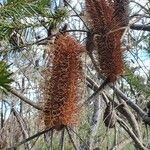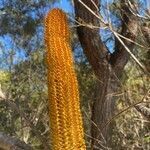Shrub to 6 m tall, without lignotuber, sometimes a small tree. Bark smooth with lenticels, becoming corky. Stems sparsely hairy. Leaves alternate, crowded; petiole 1-2 mm long; lamina narrowly linear, 9-20 mm long, 0.7-1 mm wide, truncate but mucronate; margins revolute, with a tooth each side of apex; upper surface sparsely hirsute, glabrescent; lower surface tomentose. Inflorescence 7-22 cm long; involucral bracts narrow, pubescent, persistent. Flowers golden brown to pale yellow, often mauve at base; styles golden, orange or orange-red. Perianth 19-22 mm long including limb of 2.5-3 mm, pubescent outside, hirsute inside along margins. Pistil hooked, 30-35 mm long, glabrous; pollen presenter ovoid, 0.5 mm long. Old perianths persistent but styles soon falling. Follicles numerous, oblong to rhombic, 13-22 mm long, 6-10 mm high, 4-13 mm wide, ridged along each side and convex on top, hirsute. Seed obovate, 17-20 mm long; seed body cuneate, 9-10 mm long, 4-5 mm wide, smooth outside, swollen and somewhat ridged inside.
More
A medium shrub. It grows 2-5 m high and spreads 1.5-2.5 m wide. The leaves are narrow with a blunt end. They are green above and silvery underneath. The leaves are 1-2 cm long by 0.2-0.3 cm wide. The flowers are orange-red and they have hooked styles. The flower heads are 25 cm long. The fruit are follicles. These retain the seeds at maturity.





